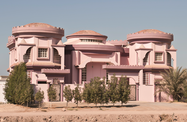From Saudi Arabia to Qatar, governments across the Gulf region are ramping up spending on building projects, with this likely to generate a host of opportunities for Ras Al Khaimah’s construction materials industry, a mainstay of the local economy.
In Saudi Arabia, the authorities are working towards a massive expansion in housing supply. As demand for homes increases in the Kingdom, real estate prices have increased too. The median price for small villas was up 20.5% in the first half of 2011 compared to the second half of 2010, according to a report by Banque Saudi Fransi. To prevent future housing shortages, the government announced a plan to build 500,000 homes and expand interest-free loan offerings.
Qatar also has a long list of construction projects leading up to the FIFA World Cup. According to the 2022 World Cup Bid Report, Qatar plans to spend $77bn on building projects leading up to the event, including hotels, stadiums, roads and railways.
Even in the UAE, where property supply tends to outpace demand for the moment, existing projects are still being finished, meaning that interior fixtures such as pipes and ceramic products are still needed. Private consultancy Ventures Middle East released a report predicting that UAE spending on interiors will rise to $821m in 2011, up from $709m in 2010, with the largest gains to be made in residential structures.
As they move off the design board and into the construction stage, these projects should mean big business for RAK’s buildings materials producers. With limited hydrocarbons reserves, RAK’s government has long placed greater emphasis on developing the emirate’s industrial capacity. Indeed, with relatively low land prices, a central location in the region and access to raw materials, the emirate has many competitive advantages when it comes to industry, and local firms have made the most of these to become significant regional players in the sector.
Founded in 1989, RAK Ceramics has grown into the world’s largest manufacturer of ceramic and porcelain tiles. The firm has posted positive numbers, despite the challenging economic conditions of the past year, announcing that its profits in 2010 were just over Dh270m ($73.5m), up from roughly Dh262m ($71.3m) in 2009. With interior finishing set to rise in the region, demand for the company’s products, including floor tiles, porcelain tiles and sanitary ware, is set to increase.
Steel production is also on the rise in the emirate. Last April RAK’s ruler, Sheikh Saud bin Saqr Al Qasimi, inaugurated a steel pipe manufacturing plant of SeAH Steel Corporation. SeAH, a South Korean company, partnered with RAK Investment Authority (RAKIA) to invest $70m in the construction of the plant. Local producers should be able to take advantage of an improving regional market for the material. Steel consumption is set to grow by 5-6% in 2011, led by construction projects in the UAE and Saudi Arabia, Al Ghurair Steel’s head of business activities, Saadath Thajudeen, said earlier this year at an exhibition in Sharjah.
The long-term growth prospects seem promising as well, thanks to the largely pro-business posture of the government and a continually improving infrastructure. The government has used a combination of RAKIA and free zones to spur growth. Free zones offer perks such as 100% foreign ownership, full income and corporate tax exemption, and 100% capital and profit repatriation, while RAKIA works to attract firms to the emirate to set up operations there.
Meanwhile, infrastructure improvements demonstrate the government’s readiness to further improve RAK’s trade links. The emirate’s fifth port facility, RAK Maritime City, was officially inaugurated by Sheikh Saud last May. The area, directly adjacent to Saqr Port, includes a dedicated harbour, 8m sq metres of leasable area, and all the legal and financial perks of operating in a free zone.
These developments have come with their own challenges. As RAK has developed rapidly, at times infrastructure has had to play catch up. In the past few weeks, power outages have affected some areas of the Northern Emirates, as summer temperatures prompt many residents to turn on the air conditioning, resulting in a sharp rise in demand. However, efforts to improve infrastructure are under way. Last March the UAE federal government announced that it would invest Dh5.7bn ($1.6bn) to improve water and electricity supplies and connections in the Northern Emirates.
With an industrial base that has seen itself through tough economic conditions, RAK seems well positioned to provide materials for the predicted regional uptick in construction. As demand grows for steel, ceramics and other products, the fortunes of the emirate’s industries stand a good chance of rising too.

